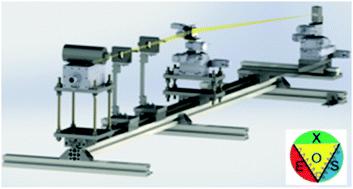当前位置:
X-MOL 学术
›
J. Anal. At. Spectrom.
›
论文详情
Our official English website, www.x-mol.net, welcomes your
feedback! (Note: you will need to create a separate account there.)
High resolution multielement XRF spectroscopy of extended and diffused sources with a graphite mosaic crystal based Von Hamos spectrometer
Journal of Analytical Atomic Spectrometry ( IF 3.1 ) Pub Date : 2019-11-05 , DOI: 10.1039/c9ja00269c A. Scordo 1, 2, 3 , L. Breschi 2, 2, 3, 4, 5 , C. Curceanu 1, 2, 3 , M. Miliucci 1, 2, 3 , F. Sirghi 1, 2, 3, 6, 7 , J. Zmeskal 8, 9, 10
Journal of Analytical Atomic Spectrometry ( IF 3.1 ) Pub Date : 2019-11-05 , DOI: 10.1039/c9ja00269c A. Scordo 1, 2, 3 , L. Breschi 2, 2, 3, 4, 5 , C. Curceanu 1, 2, 3 , M. Miliucci 1, 2, 3 , F. Sirghi 1, 2, 3, 6, 7 , J. Zmeskal 8, 9, 10
Affiliation

|
Bragg spectroscopy is a consolidated experimental method for high energy resolution X-ray measurements. However, this technique is limited to the detection of photons produced from point-like or well collimated sources and becomes quite inefficient for photons generated in extended and diffused ones; also, the possibility to perform simultaneous measurements of several X-ray lines is of great benefit when low rate signals are expected and individual angular scans require long exposure times. We present a prototype of a high resolution Highly Annealed Pyrolytic Graphite (HAPG) mosaic crystals based X-ray spectrometer, developed by the VOXES (high resolution VOn hamos X-ray spectrometer using HAPG for extended sources) collaboration at INFN Laboratories of Frascati, able to work with extended (millimetric) and isotropic sources. The spectrometer has been tested in the energy range 6–19 keV, with the aim to deliver a cost effective system having an energy resolution (FWHM) at the level of few eV, able to perform sub-eV precision measurements of single and multielement targets in a broad energy range. In this paper, the working principle of the VOXES spectrometer is presented, including a detailed description of the geometry, of the calibration methods and of the spectral fitting functions. Results of X-ray tracing simulations are compared to the experiment. The main results achieved by our spectrometer regard the peak resolutions. In particular, we report values as low as 4.02 ± 0.08 eV and 3.60 ± 0.05 eV for the Fe(Kα1,2) and Cu(Kα1,2) lines; for larger dynamic ranges, we report single shot spectra with Cu(Kα1,2) Ni(Kβ) and Zn(Kα1,2) lines with best resolution values of 5.15 ± 0.13 eV, 6.02 ± 0.24 eV and 6.20 ± 0.34 eV, respectively. Finally, we explored the capabilities of our spectrometer for energies above 15 keV, obtaining for Mo(Kα1,2) and Nb(Kβ) lines resolution values of 19.44 ± 0.75 eV and 39.90 ± 1.48 eV, respectively. The proposed spectrometer has possible applications in several fields, going from fundamental physics, synchrotron radiation and X-FEL applications, medicine and industry to hadronic physics experiments, where its performances make it a fundamental tool for a series of measurements like the energies of kaonic atoms transitions, allowing to extract fundamental parameters in the low energy QCD in the strangeness sector.
中文翻译:

基于Von Hamos光谱仪的石墨镶嵌晶体的扩展和扩散源的高分辨率多元素XRF光谱
布拉格光谱法是用于高能分辨率X射线测量的综合实验方法。但是,该技术仅限于检测从点状或准直光源产生的光子,并且对于在扩展和扩散的光子中产生的光子来说效率非常低。同样,当期望低速率信号并且单独的角度扫描需要较长的曝光时间时,同时测量多条X射线线的可能性非常有用。我们展示了由VOXES(使用HAPG作为扩展源的高分辨率Von hamos X射线光谱仪)在Frascati的INFN实验室合作开发的基于高分辨率高退火热解石墨(HAPG)镶嵌晶体的X射线光谱仪的原型。与扩展(毫米波)和各向同性源一起工作。该光谱仪已经在6-19 keV的能量范围内进行了测试,目的是提供一种具有成本效益的系统,其能量分辨率(FWHM)处于几个eV的水平,能够对单个和多个元素的目标进行亚eV的精确测量在宽广的能量范围内。本文介绍了VOXES光谱仪的工作原理,包括对几何形状,校准方法和光谱拟合功能的详细描述。X射线跟踪模拟的结果与实验进行了比较。我们的光谱仪获得的主要结果与峰分辨率有关。特别是,我们报告的Fe(Kα)值低至4.02±0.08 eV和3.60±0.05 eV 能够在较宽的能量范围内对单元素和多元素目标进行亚eV精度测量。本文介绍了VOXES光谱仪的工作原理,包括几何形状,校准方法和光谱拟合功能的详细说明。X射线跟踪模拟的结果与实验进行了比较。我们的光谱仪获得的主要结果与峰分辨率有关。特别是,我们报告的Fe(Kα)值低至4.02±0.08 eV和3.60±0.05 eV 能够在较宽的能量范围内对单元素和多元素目标进行亚eV精度测量。本文介绍了VOXES光谱仪的工作原理,包括对几何形状,校准方法和光谱拟合功能的详细描述。X射线跟踪模拟的结果与实验进行了比较。我们的光谱仪获得的主要结果与峰分辨率有关。特别是,我们报告的Fe(Kα)值低至4.02±0.08 eV和3.60±0.05 eV X射线跟踪模拟的结果与实验进行了比较。我们的光谱仪获得的主要结果与峰分辨率有关。特别是,我们报告的Fe(Kα)值低至4.02±0.08 eV和3.60±0.05 eV X射线跟踪模拟的结果与实验进行了比较。我们的光谱仪获得的主要结果与峰分辨率有关。特别是,我们报告的Fe(Kα)值低至4.02±0.08 eV和3.60±0.05 eV1,2)和Cu(Kα 1,2)线; 对于较大的动态范围,我们报告用的Cu(Kα单发光谱1,2)的Ni(Kβ)和Zn(Kα 1,2)与5.15±0.13电子伏特的最佳分辨率值的行,6.02±0.24 eV和6.20±0.34电子伏特, 分别。最后,我们探讨了以上15千电子伏的能量光谱的能力,获得了莫(Kα 1,2)和Nb(Kβ)线的分辨率值分别为19.44±0.75 eV和39.90±1.48 eV。拟议的光谱仪在基础物理学,同步加速器辐射和X-FEL应用,医学和工业到强子物理实验等多个领域都有可能的应用,其性能使其成为进行一系列测量(如钾原子能量)的基础工具过渡,从而可以提取低能量QCD中陌生扇区中的基本参数。
更新日期:2019-11-05
中文翻译:

基于Von Hamos光谱仪的石墨镶嵌晶体的扩展和扩散源的高分辨率多元素XRF光谱
布拉格光谱法是用于高能分辨率X射线测量的综合实验方法。但是,该技术仅限于检测从点状或准直光源产生的光子,并且对于在扩展和扩散的光子中产生的光子来说效率非常低。同样,当期望低速率信号并且单独的角度扫描需要较长的曝光时间时,同时测量多条X射线线的可能性非常有用。我们展示了由VOXES(使用HAPG作为扩展源的高分辨率Von hamos X射线光谱仪)在Frascati的INFN实验室合作开发的基于高分辨率高退火热解石墨(HAPG)镶嵌晶体的X射线光谱仪的原型。与扩展(毫米波)和各向同性源一起工作。该光谱仪已经在6-19 keV的能量范围内进行了测试,目的是提供一种具有成本效益的系统,其能量分辨率(FWHM)处于几个eV的水平,能够对单个和多个元素的目标进行亚eV的精确测量在宽广的能量范围内。本文介绍了VOXES光谱仪的工作原理,包括对几何形状,校准方法和光谱拟合功能的详细描述。X射线跟踪模拟的结果与实验进行了比较。我们的光谱仪获得的主要结果与峰分辨率有关。特别是,我们报告的Fe(Kα)值低至4.02±0.08 eV和3.60±0.05 eV 能够在较宽的能量范围内对单元素和多元素目标进行亚eV精度测量。本文介绍了VOXES光谱仪的工作原理,包括几何形状,校准方法和光谱拟合功能的详细说明。X射线跟踪模拟的结果与实验进行了比较。我们的光谱仪获得的主要结果与峰分辨率有关。特别是,我们报告的Fe(Kα)值低至4.02±0.08 eV和3.60±0.05 eV 能够在较宽的能量范围内对单元素和多元素目标进行亚eV精度测量。本文介绍了VOXES光谱仪的工作原理,包括对几何形状,校准方法和光谱拟合功能的详细描述。X射线跟踪模拟的结果与实验进行了比较。我们的光谱仪获得的主要结果与峰分辨率有关。特别是,我们报告的Fe(Kα)值低至4.02±0.08 eV和3.60±0.05 eV X射线跟踪模拟的结果与实验进行了比较。我们的光谱仪获得的主要结果与峰分辨率有关。特别是,我们报告的Fe(Kα)值低至4.02±0.08 eV和3.60±0.05 eV X射线跟踪模拟的结果与实验进行了比较。我们的光谱仪获得的主要结果与峰分辨率有关。特别是,我们报告的Fe(Kα)值低至4.02±0.08 eV和3.60±0.05 eV1,2)和Cu(Kα 1,2)线; 对于较大的动态范围,我们报告用的Cu(Kα单发光谱1,2)的Ni(Kβ)和Zn(Kα 1,2)与5.15±0.13电子伏特的最佳分辨率值的行,6.02±0.24 eV和6.20±0.34电子伏特, 分别。最后,我们探讨了以上15千电子伏的能量光谱的能力,获得了莫(Kα 1,2)和Nb(Kβ)线的分辨率值分别为19.44±0.75 eV和39.90±1.48 eV。拟议的光谱仪在基础物理学,同步加速器辐射和X-FEL应用,医学和工业到强子物理实验等多个领域都有可能的应用,其性能使其成为进行一系列测量(如钾原子能量)的基础工具过渡,从而可以提取低能量QCD中陌生扇区中的基本参数。











































 京公网安备 11010802027423号
京公网安备 11010802027423号